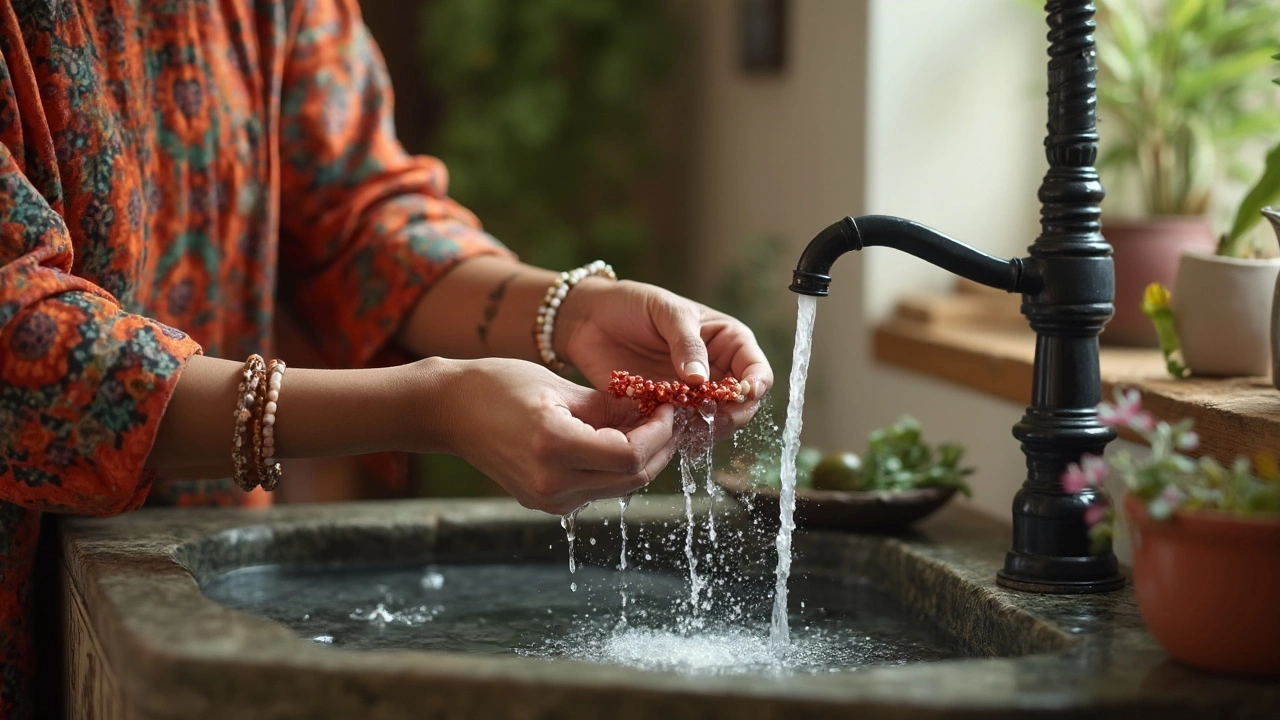Ever noticed how your favorite bracelet loses its shine after you forget to take it off before a swim? Or how your handcrafted necklace sometimes starts to look dull after just a few steamy showers? If you’re using a jewelry making kit for your creations, waterproofing isn’t just a nice bonus—it’s a must if you want your hard work to last.
You don’t need fancy tools or a chemistry degree to protect your pieces. There are coatings you can brush on that seal metals and beads, and a few tricks that work better than anything your grandma used. Knowing which materials to use—and which to avoid—makes all the difference. Even something as simple as a clear nail polish can be a quick fix for rings or costume earrings if you’re in a pinch. But the real magic comes from using proper sealants and materials designed to stand up to water in the first place.
So forget the horror stories about jewelry turning green or getting ruined by rain—there are ways to stop all that without breaking the bank. Ready for practical steps that actually work? Let’s get your creations ready for anything life throws at them, from that surprise downpour to your next beach trip.
- Why Waterproofing Your Jewelry Matters
- Seeing Through the Myths: What Really Needs Protection
- Best Materials for Waterproof Jewelry
- DIY Coatings and Sealants That Work
- Waterproofing Steps for Popular Jewelry Types
- How to Keep Jewelry Waterproof Over Time
Why Waterproofing Your Jewelry Matters
If you’ve made something with a jewelry making kit, you already know how much time and effort it takes. But here’s the problem—almost every type of jewelry will break down if it’s not protected from water. Water can cause metals to tarnish, beads to lose color, and elastic strings to weaken and snap. That means your favorite DIY bracelet could look rough after just a couple of showers or dips in the pool.
Not every material reacts to water in the same way. Brass and copper turn green and leave marks on your skin. Plated metals eventually wear down to the base layer. Even so-called stainless steel can pit or rust over time if water gets in through tiny scratches. And if you’re a fan of costume jewelry or anything with glued parts, water is their worst enemy—glue breaks down, stones fall out, and your piece basically falls apart.
Fun fact—one small study found that over 60% of folks who wear jewelry daily see at least some tarnishing or color fading within the first three months, mostly because of water exposure. That lines up with what most DIYers notice: sweat, rain, and hand-washing all pile up fast.
The good news? When you focus on making waterproof jewelry, you don’t just stop discoloration—you make sure your pieces look fresh for much longer. And let’s be honest, nobody wants to replace their favorite ring every few weeks because it turns their finger green.
- Waterproofing helps stop tarnish and dullness, especially on cheap metals.
- It keeps beads, strings, and cords from snapping or rotting.
- Sealed jewelry stands up better to lotions, sweat, and, yes, even accidental dunks in the pool.
When you’re using DIY jewelry tips or choosing which jewelry making kits to buy, go for options that talk about water resistance. It’ll save you money and hassle in the long run—and your creations will stay looking as good as new, no matter where you take them.
Seeing Through the Myths: What Really Needs Protection
People often assume all jewelry needs the same level of care, but that's not true. For starters, pure gold and high-quality stainless steel are actually pretty tough in water. Gold won’t rust or tarnish from a regular shower, so you don’t need to panic if you forget to take off your gold chain. Where things get tricky is with plated metals (like gold-plated brass) and copper—they lose their finish fast when they get wet. Fake jewelry from most jewellery making kits falls into this risk zone unless you use the right sealant.
Natural materials like wood, leather, and some gemstones absorb moisture, which can cause stains, cracks, or color fading. Pearls hate water too—it eats away their luster in no time. Resin, which is a DIY favorite, actually handles water pretty well after it’s fully cured, but only if there aren’t tiny cracks or bubbles where water can sneak in.
Here are the things that really need protection if water is involved:
- Plated metals or any non-solid gold and silver (think bronze, brass, copper)
- Natural materials like wood, seeds, shells, leather, or fabric
- Soft and porous stones (turquoise, opal, and hematite get damaged quickly)
- Anything glued together, as water weakens most standard jewelry glues
Let's break down some popular materials and their water resistance for a clear view:
| Material | Water Safe? | Notes |
|---|---|---|
| Stainless Steel | Yes | Rarely rusts, great for daily wear |
| Gold-Plated Brass | No | Plating wears off quickly with water |
| Natural Stones (Porous) | No | Can absorb water, leading to cracks |
| Resin (Cured) | Yes | Water-resistant if there's no damage |
| Wood | No | Absorbs moisture, swells or stains |
So next time you’re making DIY jewelry, don’t just seal everything blindly. Focus your waterproofing on the pieces and parts that actually need it. That way, you’re not just saving time—you’re making sure your creations last longer and keep looking sharp. That’s how you really make the most out of your DIY jewelry tips, not just guessing and hoping for the best.
Best Materials for Waterproof Jewelry
If you want jewelry that’ll survive showers, pools, and daily wear, picking the right materials makes life easy. Smart choices mean you spend less time fixing and more time wearing what you make. Here’s what stands up to water without all the drama—especially if you’re working with jewelry making kits that already include a mix of parts.
- Stainless steel: Practically invincible when it comes to water. It doesn't rust, corrode, or turn green. That’s why you see it used in pro-level watches and body jewelry all the time. If you want no-fuss waterproof jewelry, stainless is a hero.
- Titanium: Super light, super tough. Titanium won’t react with sweat or water, and it’s great for sensitive skin. It does cost more (and usually doesn’t come in basic kids’ kits) but gives a pro look and feel.
- Silicone: Pure silicone is flexible, comfy, and absolutely waterproof. It’s perfect for rings, bracelets, and chunky beads. You’ll spot it in a lot of summer festival or sports jewelry.
- Ceramic and glass beads: Glazed ceramic and glass won’t break down in water. Just avoid beads with painted finishes or decals unless they’re sealed.
- 14k gold-filled or solid gold: Gold-plating fades fast, but solid gold or 14k gold-filled pieces actually hold up way better against water, especially for earrings or chain necklaces.
- High-grade plastics and acrylics: These are great for fun colors and bold looks. Acrylic doesn’t mind water unless it’s been painted on top.
Let’s keep it real: some materials are straight-up trouble for waterproof jewelry. Avoid regular steel (it rusts), base metals (like cheap copper or brass), untreated leather, and wooden beads if you want your creations to outlast the first rainstorm. Even sterling silver can tarnish fast when wet often, unless you seal it or wear it only occasionally. If in doubt, a quick check with a magnet can help—steel sticks, stainless steel mostly doesn’t.
| Material | Water Resistance | Common in Kits? |
|---|---|---|
| Stainless Steel | Excellent | Yes |
| Titanium | Excellent | Sometimes |
| Silver (Sterling) | Fair (can tarnish) | Yes |
| Gold-Filled/Solid Gold | Very Good | Rare |
| Silicone | Excellent | Yes |
| Plastic/Acrylic | Good | Yes |
| Ceramic/Glass Beads | Very Good | Yes |
| Leather/Wood | Poor | Yes |
So, before building that waterproof project from your kit, check what each piece is made from. With the right material, you’re halfway to a piece that lasts no matter what.

DIY Coatings and Sealants That Work
If you want your waterproof jewelry to actually survive daily wear—sweat, showers, and maybe even a dip in the ocean—you’ll need tried-and-tested coatings. Not every spray or dip on the shelf delivers the same results, so let’s get into what works and what doesn’t.
The biggest winner for DIY jewelry makers is jewelry resin. Clear epoxy resins (like EnviroTex Lite or ICE Resin) create a hard, glass-like shell over beads, charms, and even wire-wrapped pieces. These resins are nontoxic once dried, and they’re safe for skin contact.
- Clear nail polish: Super common and easy to use. Just paint a couple of thin layers on metals, beads, and clasps. It stops tarnishing and protects against water, but you’ll need to reapply every few months because it wears off.
- Renaissance Wax: This stuff is used by museums for a reason. Rub a small amount on finished pieces, buff gently, and it forms an invisible barrier. Great for copper, silver, and base metal charms. Also works on beads and crystals.
- Spray sealants: Krylon’s Crystal Clear Acrylic spray and Mod Podge Clear Acrylic Sealer are easy finds at craft stores. Lay your jewelry on wax paper, spray from about a foot away, and let dry between coats. These work best on costume pieces or creations with lots of nooks and crannies.
- Resin dips: For beads and pendants you make yourself, dipping them in a 2-part resin gives a full waterproof layer. Don’t use these on delicate chains, though—they get stiff.
If you’re after the pros and cons, check out this quick comparison:
| Coating/Sealant | Durability | Reapplication? | Works Best On |
|---|---|---|---|
| Clear Nail Polish | Low-Mod | Yes (3-6 months) | Small metal parts |
| Renaissance Wax | Mod-High | Yes (yearly) | Metal, beads |
| Acrylic Spray | Mod | Yes (6-12 months) | All-over pieces |
| Epoxy Resin | High | No | Pendants, focal beads |
Here’s a tip: always make sure your jewelry making kit creations are clean and dry before coating. Dirt or oils can mess with how these coatings stick. Also, don’t rush drying time—most sprays and resins need at least 24 hours to fully cure. It makes a difference to the waterproof seal.
Sealants aren’t magic, but if you use the right one for your piece, your DIY jewelry can handle rain, sweat, and handwashing way better than you’d expect. Mix and match these options and find what keeps your personal style safe from water adventures.
Waterproofing Steps for Popular Jewelry Types
If you’re making jewelry with a kit at home, you’ve probably noticed not all pieces hold up the same in water. Here’s a breakdown of how to waterproof different jewelry types using easy tricks and real materials—no magic needed.
- Beaded Jewelry: Most beads, especially glass or ceramic, are naturally water-resistant. It’s the string or wire that you need to worry about. For stretchy bracelets, use coated elastic or memory wire—never plain cotton thread. Before finishing, brush the knots and ends with clear jewelry glue or a waterproof sealant like Mod Podge Outdoor. This seals the core weak spots.
- Metal Jewelry (like earrings and chain necklaces): Stainless steel and titanium pieces are nearly waterproof already, but for plated metals or costume jewelry, it’s another story. After assembling, coat the metal (except areas inside clasps or posts) with a thin layer of clear nail polish, jewelry resin, or a spray-on acrylic sealer. Do this in a well-ventilated space and let it dry fully. This creates an invisible shield that helps fight off moisture and tarnish. For an extra layer, reapply after a month or so.
- Polymer Clay Creations: If you’ve made earrings or pendants from polymer clay, always use a waterproof sealer once baked. A polyurethane varnish or a marine-grade epoxy resin works great. Always cure your pieces per the brand’s instructions to avoid sticky results. These sealers lock out water and keep colors bright, even after a few accidental dunks.
- Leather and Fabric Jewelry: Use a waterproof spray made for shoes or bags—just a light mist on both sides will do. Let it air out completely. Don’t go overboard, or it may darken the leather.
Here’s a quick comparison showing how long typical jewelry materials can stand up to water, unprotected versus sealed:
| Jewelry Material | Unprotected Water Tolerance | With Sealant/Coating |
|---|---|---|
| Stainless Steel | Indefinite | Not needed |
| Plated Metal | 2-3 exposures before tarnish | Up to 6 months |
| Elastic String (Uncoated) | 1-2 exposures | 10+ exposures |
| Polymer Clay (Unsealed) | May absorb after 1-2 exposures | Waterproof for daily wear |
| Leather | 1 exposure, may stain | 3-6 exposures |
Don’t forget the small spots—clasps and knots often get missed, but these are where water easily sneaks in. Even if your piece says "waterproof," recheck the seal every few months if you wear it in the shower or pool.
If you’re working with waterproof jewelry ideas from jewelry making kits, using the right coatings means less fixing later and more time actually wearing your own designs. It’s way easier to keep jewelry waterproof than to try and fix it after the fact.
How to Keep Jewelry Waterproof Over Time
Making your jewelry waterproof is one thing. Keeping it protected for months (and years) is where most people slip up. Even after using all the right coatings, you’ve got to check in on your pieces every so often—especially if you wear them in the shower, at the pool, or while working out. Water isn’t the only culprit; sweat, soaps, sunscreen, and just everyday wear can eat away at even the best sealants.
"Don’t count on a single application of sealant to last forever. Even with premium coatings, regular touch-ups keep jewelry looking fresh and water-safe," says Sandra Rhodes, pro jewelry maker and content creator at The Bead Daily.
Here’s how to keep your waterproof jewelry in top shape:
- Inspect Regularly: Every month or two, take a close look at your pieces. If you spot dulling, cracks, or any peel in the sealant, that’s your cue. Don’t wait until water damage shows.
- Reapply Sealants: Most sealants need a new coat every 3-6 months, especially if your jewelry sees a lot of action. A quick layer of clear jewelry-grade resin, Mod Podge, or UV glaze does the trick.
- Dry It Right Away: After exposure to water (showers, rain, swimming), dry the jewelry with a soft cloth ASAP. Don’t let moisture sit—that’s when trouble starts.
- Avoid Harsh Chemicals: Skip perfumes, lotions, and household cleaners while wearing your jewelry. These can chew through coatings faster than water alone.
- Store Smart: When you’re not wearing it, pop your jewelry in a dry, zippered bag or an airtight box with a silica gel packet. This limits humidity and helps your coating last way longer.
On average, people who stay on top of resealing their DIY jewelry every six months report up to 80% longer life for their creations compared to those who never bother:
| Care Frequency | Jewelry Lifespan Increase |
|---|---|
| Every 6 months | +80% |
| Once a year | +40% |
| Never | — |
It’s really just about being proactive. If you invest a little time now and then, your DIY waterproof jewelry won’t just survive a dip in the pool, it’ll keep turning heads for years.



